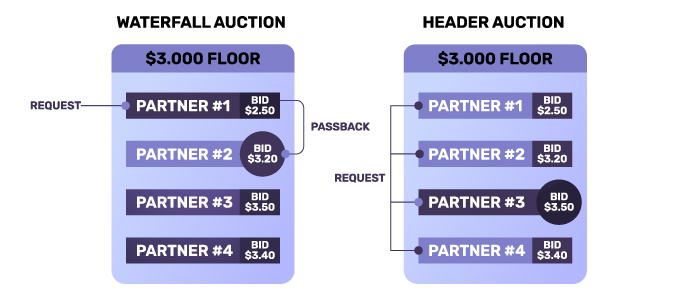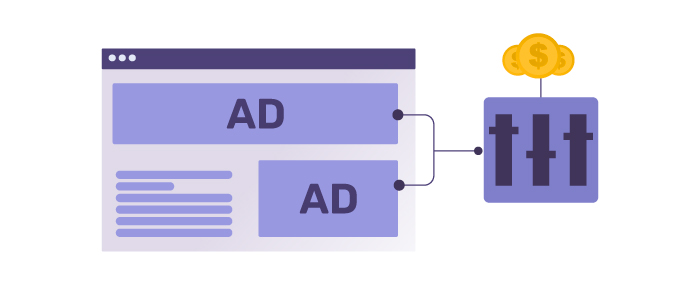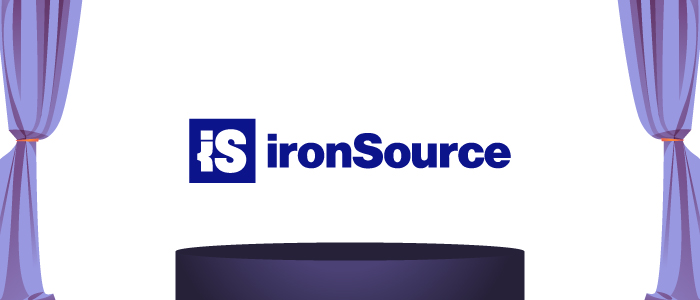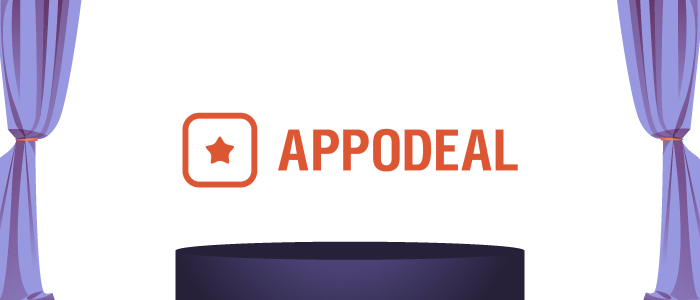Your Ad Mediation Guide Inside & Out
In the adtech industry, publishers want to make as much money as possible without annoying users. And this is normal. Who wouldn’t want to earn money from their hard work as a publisher?
In pursuit of making more money, ad mediation comes in. Instead of working with just one ad network, ad mediation brings together different ad networks in one place. Thus helping publishers get the best deals for every ad spot. But ad mediation isn’t just about that.
This article discusses everything you must know about ad mediation, from what it is to how it works. Read until the end and discover some of the top ad mediation platforms currently on the market.
Let’s dive in!
Table of Contents
What is Ad Mediation?
Ad mediation is a solution that lets publishers connect with multiple advertisers/ad networks through a single SDK integration, making it easier for them to offer their ad space to a broad audience.
The main goal is to boost ad revenue by increasing eCPM, improving ad fill rates, and enhancing overall efficiency.
To calculate the total ad revenue generated through ad mediation, we can use the following formula:

Remember that though widely and generally used in app development, ad mediation isn’t limited to apps alone. It can be applied to various digital platforms to maximize ad monetization.
What is a Mediation SDK?
A Mediation SDK (Software Development Kit) is a set of tools and code libraries developers integrate into their mobile app websites to manage and optimize ad placements across multiple ad networks.
Basically, it acts as a bridge between the publisher (who owns the app or website) and various advertisers. As a result, it allows the publisher to maximize ad revenue by automatically selecting the highest-paying ads.
The Mediation SDK simplifies the process by offering a single integration point. Instead of manually connecting to and managing multiple ad networks, the SDK handles it all, routing ads from different networks through one system.
How Does Ad Mediation Work?
As mentioned, ad mediation allows app or website publishers to connect with multiple ad networks through a single platform.
The publisher adds the ad mediation platform’s SDK (software development kit) to its app or website, which helps gather information about its audience. When a user opens the app or visits the site, the SDK requests that the mediation platform display an ad.
Once the request is made, advertisers compete against each other to show their ads on that app or website. The way this competition happens depends on the type of ad mediation platform being used.
There are two main methods: waterfall vs. header bidding.

In a waterfall auction, the process is pretty straightforward. The platform checks ad networks in a specific order. It starts with the top-ranked network. If that network doesn’t have an ad to show, it moves to the next one, and so on, until it finds an ad or reaches the end of the list. It’s simple but may not always maximize revenue because the highest-paying ad might not always be at the top of the list.
Header bidding is a more competitive and modern method. Instead of going through ad networks individually, they all get to bid on the ad space simultaneously. The highest bidder wins, leading to better earnings for the publisher. However, header bidding is more complex to set up and requires some specialized tools and knowledge.
We will talk more about these methods below.
After the bidding, the advertiser who wins gets their ad displayed in the publisher’s available ad space. This whole process happens in real-time, ensuring that the most relevant and highest-paying ads are shown to users.
Also, check our Header Bidding vs. RTB guide for a more in-depth analysis.
3 Optimizing Methods Used in Ad Mediation
Ad mediation platforms use various methods to optimize ad revenue and manage the delivery of ads across different networks. These include traditional methods like waterfall bidding, header bidding, in-app bidding, and automated approaches like programmatic advertising.
Other methods of ad mediation also exist, such as server-side mediation, dynamic floor pricing, and cross-platform mediation.
However, the most well-known and popular are waterfall bidding, header bidding (including its in-app variant), and programmatic advertising. Additionally, some ad mediation platforms can use hybrid models.
1. Waterfall Bidding
Waterfall Bidding is a traditional ad mediation method where ad networks are prioritized sequentially. In this model, the ad server attempts to fill an ad request with the highest-priority network.
If that network fails to provide an ad, the request moves to the next network in the priority list. Thus continuing until the ad is filled or all networks are exhausted.
While straightforward and easy to manage, waterfall bidding can limit revenue potential since higher-paying opportunities might be missed if they are lower in the waterfall.
Additionally, this approach can introduce latency due to the sequential nature of requests. It was the most popular method of ad mediation before the advent of more advanced techniques.
2. Header Bidding
Header bidding is an advanced method that allows multiple demand sources to bid on ad inventory simultaneously before the ad server is called.
By placing JavaScript code in the header of a webpage or app, header bidding collects bids from various demand sources in real-time, enabling the ad server to select the highest bid.
This increases revenue potential by enhancing competition and offering better bid performance transparency.
However, it can be complex to implement and, if not optimized, may impact performance.
In-app header bidding operates similarly to header bidding but is specifically designed for mobile apps. It allows app publishers to manage multiple demand sources and optimize ad revenue in the mobile environment.
Among these, in-app bidding—which is considered equivalent to header bidding but within mobile apps—is recognized as the most lucrative type of ad mediation. It offers significant revenue potential and efficiency advantages by enabling real-time competition among demand sources for mobile ad inventory.
3. Programmatic Advertising
Programmatic Advertising involves using automated systems and algorithms to buy and sell ad inventory in real-time, typically through Real-Time Bidding (RTB) and programmatic direct deals.
This approach leverages demand-side platforms (DSPs) and supply-side platforms (SSPs) to facilitate efficient, data-driven ad transactions.
Programmatic advertising optimizes ad delivery through precise targeting and real-time data analysis, maximizing advertiser ROI and publisher revenue. Despite its benefits, it can be complex to manage and sometimes lacks transparency.
Top Ad Mediation Benefits for Publishers and Advertisers

Benefits for Publishers
1. Boosted Revenue
One of the biggest advantages of ad mediation is its ability to create competition among ad networks.
When multiple networks bid for the same ad space, it often results in higher eCPMs (effective cost per mille), meaning publishers earn more for each ad impression shown. This competitive environment ensures publishers maximize their earnings by always serving the highest-paying ads.
2. Better Ad Fill Rates
When relying on just one ad network, there’s always the risk of leaving ad space unfilled.
Ad mediation solves this problem by connecting publishers to multiple networks, ensuring that if one doesn’t have an ad to display, another one will. This means fewer empty ad slots and more opportunities to generate revenue from every available impression.
3. Streamlined Management
Managing multiple ad networks manually can be a headache, requiring time and effort to juggle various dashboards, reporting systems, and optimization strategies.
Ad mediation simplifies this process by offering a centralized platform that handles everything in one place. This reduces operational complexity, allowing publishers to focus more on their content than ad management.
4. Enhanced User Experience
A positive user experience is vital for retaining an audience, and ad mediation can contribute to this by delivering more relevant, less disruptive ads.
By selecting ads that align with the content and the user’s interests, mediation platforms help ensure that ads blend more seamlessly into the experience, avoiding the pitfalls of overly aggressive or irrelevant advertising.
5. Greater Flexibility
Ad mediation allows publishers to experiment with different ad formats, placements, and networks, making finding the right balance for their audience easier.
Whether it’s testing banner ads versus interstitials or adjusting placements to improve engagement, mediation platforms provide the flexibility to optimize ad strategies and tailor them to the unique needs of each publisher’s content.
Benefits for Advertisers
1. Broadened Audience Reach
Advertisers can use an ad mediation platform to tap into a broad network of potential customers across various ad networks.
In this way, their ads are not limited to just one network but can be seen by a much larger and more diverse audience. A broader reach boosts brand visibility and ensures that marketing messages are seen by various users, helping advertisers build a stronger brand presence.
2. Enhanced Targeting Capabilities
Ad mediation platforms come with advanced targeting tools that allow advertisers to refine their audience based on specific factors such as age, location, interests, and online behavior.
By targeting ads more accurately, advertisers can improve the relevance of their campaigns, increase engagement rates, and get more value from their advertising spend. This precise approach helps ensure that their ads are seen by the right people at the right time.
3. Cost-Effective Bidding
A major benefit of ad mediation is the ability to engage in real-time bidding for ad space. Instead of paying a fixed rate, advertisers can bid for ad placements based on how valuable they think each impression is.
This real-time bidding process ensures that advertisers only pay for impressions that provide real value, allowing for more strategic budget management. By competing for ad space in this way, advertisers can make their spending more efficient and achieve better returns on their investment.
4. Detailed Performance Analytics
Ad mediation platforms offer comprehensive analytics and reporting features that give advertisers a clear view of their ads’ performance. These tools track important metrics like click-through rates, conversion rates, and cost-per-click, providing valuable insights into campaign effectiveness.
With this data, advertisers can see what’s working and what’s not, allowing them to make informed decisions and continually improve their campaigns.
5. Fair Competitive Environment
Ad mediation creates a more level playing field by preventing any single ad network from dominating the ad space.
This encourages a fair, competitive environment where all advertisers have an equal opportunity to reach their target audience. Innovation thrives in this healthier advertising ecosystem as different networks and platforms strive to offer the best services and solutions.
Top 3 Ad Mediation Platforms
1. Google AdMob

Google AdMob is one of the most widely recognized ad mediation platforms, trusted by publishers to maximize their ad revenue while simplifying the entire ad management process.
As a comprehensive solution, AdMob connects publishers to multiple ad sources, including the AdMob network, third-party networks, and custom AdMob campaigns.
What separates Google AdMob is how it streamlines ad mediation through mediation groups. These groups allow publishers to segment their ad traffic strategically, tailoring the experience across different ad formats, platforms, and regions. This flexibility empowers publishers to optimize their earnings and reach a wider audience.
In addition to supporting various ad formats, AdMob provides robust tools and insightful analytics, helping publishers understand their audience better and fine-tune their monetization strategies for long-term growth.
2. ironSource

ironSource is another leading ad mediation platform designed to help app developers maximize their revenue and boost eCPMs effortlessly.
With access to over 15 ad networks, ironSource takes the complexity out of app monetization by managing multiple networks on your behalf. As a result, saving developers time simplifies the process of generating revenue from their apps.
ironSource also offers the flexibility to customize your monetization strategy, allowing you to combine various mediation models for optimal results. One of ironSource’s key strengths is its support for diverse ad formats. To name a few, there’s the rewarded video, offer walls, interstitial ads, and banner ads, which provide developers with multiple avenues to increase earnings.
Moreover, the platform allows you to track essential metrics DAU (Daily Active Users), ARPDAU (Average Revenue Per Daily Active User), and engagement. This gives you the insights to fine-tune your strategy and achieve sustained growth.
3. Appodeal

Appodeal is a top-tier mobile ad mediation platform that supports more than 60 major ad networks. With so many ad networks competing for your inventory, Appodeal ensures a consistently high fill rate, giving you the best chance to monetize every available ad opportunity.
The platform supports all four major ad formats: interstitial ads (rich media, static, video), banners, rewarded videos, and native ads. This variety allows you to choose the most effective ad placements, enhancing your app’s overall user experience while optimizing your revenue streams.
One of Appodeal’s standout features is parallel bidding, a cutting-edge solution for header bidding that is steadily replacing the traditional waterfall model. Unlike waterfall bidding, where ad requests are handled one at a time, parallel bidding allows ad requests to be made simultaneously. This results in more competition for ad space, leading to higher earnings, with Appodeal reporting a 17% increase in eCPM and a 30% boost in ARPDAU.
Conclusion
Ad mediation is a game-changer for publishers who want to make more money from their ads while keeping their users happy.
Platforms like Google AdMob, ironSource, and Appodeal are great examples of how ad mediation can help. They offer tools and features that make it easier to get the most out of your ads, whether it’s through advanced bidding methods or flexible ad formats.
Ad mediation can simplify ad management, boost earnings, and engage users with relevant ads.